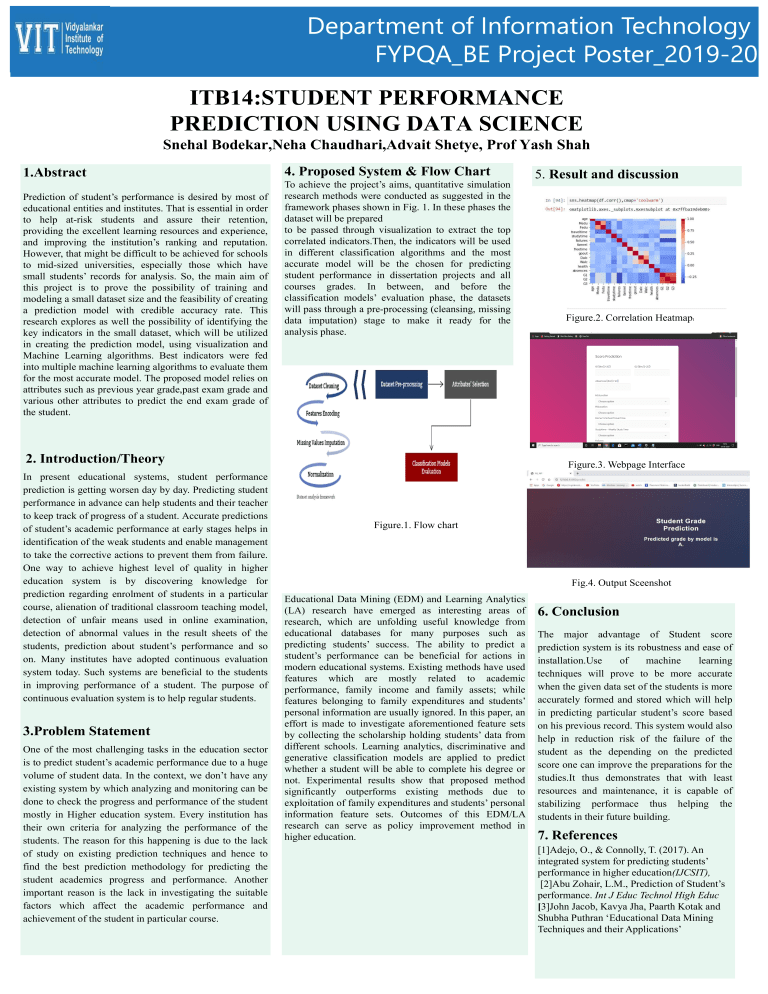
Department of Information Technology FYPQA_BE Project Poster_2019-20 ITB14:STUDENT PERFORMANCE PREDICTION USING DATA SCIENCE Snehal Bodekar,Neha Chaudhari,Advait Shetye, Prof Yash Shah 1.Abstract Prediction of student’s performance is desired by most of educational entities and institutes. That is essential in order to help at-risk students and assure their retention, providing the excellent learning resources and experience, and improving the institution’s ranking and reputation. However, that might be difficult to be achieved for schools to mid-sized universities, especially those which have small students’ records for analysis. So, the main aim of this project is to prove the possibility of training and modeling a small dataset size and the feasibility of creating a prediction model with credible accuracy rate. This research explores as well the possibility of identifying the key indicators in the small dataset, which will be utilized in creating the prediction model, using visualization and Machine Learning algorithms. Best indicators were fed into multiple machine learning algorithms to evaluate them for the most accurate model. The proposed model relies on attributes such as previous year grade,past exam grade and various other attributes to predict the end exam grade of the student. 4. Proposed System & Flow Chart To achieve the project’s aims, quantitative simulation research methods were conducted as suggested in the framework phases shown in Fig. 1. In these phases the dataset will be prepared to be passed through visualization to extract the top correlated indicators.Then, the indicators will be used in different classification algorithms and the most accurate model will be the chosen for predicting student performance in dissertation projects and all courses grades. In between, and before the classification models’ evaluation phase, the datasets will pass through a pre-processing (cleansing, missing data imputation) stage to make it ready for the analysis phase. 2. Introduction/Theory In present educational systems, student performance prediction is getting worsen day by day. Predicting student performance in advance can help students and their teacher to keep track of progress of a student. Accurate predictions of student’s academic performance at early stages helps in identification of the weak students and enable management to take the corrective actions to prevent them from failure. One way to achieve highest level of quality in higher education system is by discovering knowledge for prediction regarding enrolment of students in a particular course, alienation of traditional classroom teaching model, detection of unfair means used in online examination, detection of abnormal values in the result sheets of the students, prediction about student’s performance and so on. Many institutes have adopted continuous evaluation system today. Such systems are beneficial to the students in improving performance of a student. The purpose of continuous evaluation system is to help regular students. 3.Problem Statement One of the most challenging tasks in the education sector is to predict student’s academic performance due to a huge volume of student data. In the context, we don’t have any existing system by which analyzing and monitoring can be done to check the progress and performance of the student mostly in Higher education system. Every institution has their own criteria for analyzing the performance of the students. The reason for this happening is due to the lack of study on existing prediction techniques and hence to find the best prediction methodology for predicting the student academics progress and performance. Another important reason is the lack in investigating the suitable factors which affect the academic performance and achievement of the student in particular course. 5. Result and discussion Figure.2. Correlation Heatmapt Figure.3. Webpage Interface Figure.1. Flow chart Fig.4. Output Sceenshot Educational Data Mining (EDM) and Learning Analytics (LA) research have emerged as interesting areas of research, which are unfolding useful knowledge from educational databases for many purposes such as predicting students’ success. The ability to predict a student’s performance can be beneficial for actions in modern educational systems. Existing methods have used features which are mostly related to academic performance, family income and family assets; while features belonging to family expenditures and students’ personal information are usually ignored. In this paper, an effort is made to investigate aforementioned feature sets by collecting the scholarship holding students’ data from different schools. Learning analytics, discriminative and generative classification models are applied to predict whether a student will be able to complete his degree or not. Experimental results show that proposed method significantly outperforms existing methods due to exploitation of family expenditures and students’ personal information feature sets. Outcomes of this EDM/LA research can serve as policy improvement method in higher education. 6. Conclusion The major advantage of Student score prediction system is its robustness and ease of installation.Use of machine learning techniques will prove to be more accurate when the given data set of the students is more accurately formed and stored which will help in predicting particular student’s score based on his previous record. This system would also help in reduction risk of the failure of the student as the depending on the predicted score one can improve the preparations for the studies.It thus demonstrates that with least resources and maintenance, it is capable of stabilizing performace thus helping the students in their future building. 7. References [1]Adejo, O., & Connolly, T. (2017). An integrated system for predicting students’ performance in higher education(IJCSIT), [2]Abu Zohair, L.M., Prediction of Student’s performance. Int J Educ Technol High Educ [3]John Jacob, Kavya Jha, Paarth Kotak and Shubha Puthran ‘Educational Data Mining Techniques and their Applications’


